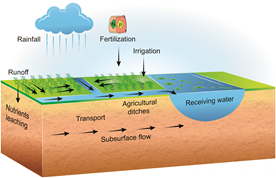International Journal of
eISSN: 2576-4454


Mini Review Volume 7 Issue 2
1Quality Management System, Dangote Cement, Cameroon
2Quality control, Ministry of Agriculture and Rural Development, Cameroon
Correspondence: Abanda Well Victorien Bienvenu, Department of Quality Management System, Dangote Cement Cameroon, Cameroon, Tel +237 696871804
Received: April 15, 2023 | Published: May 11, 2023
Citation: Abanda WVB, Martha EM. Mitigation of eutrophication from agricultural runoff: the case of the agricultural region of Moungo in Cameroon. Int J Hydro. 2023;7(2):78-79. DOI: 10.15406/ijh.2023.07.00342
Eutrophication is one of the harmful phenomena which affects continental water (rivers, lakes, springs, etc.) due to the injection of N and P. If it is easy to manage point source pollution, non-point source pollution still represents a challenge. Management practices such as tillage technics, fertilizer management, and wetlands appear as solutions to remove N and P from runoff water.
Keywords: eutrophication, fertilizer, tillage, runoff water, P and N
Water is the most important resource of the earth. It is used for almost all of man’s needs. Population growth drastically leads to water stress.1 One of the tangible consequences of water stress is the so called eutrophication which is the degradation of water bodies due to excess quantities of nutrients (P and N in particular). One of these nutrients (nitrogen) is mainly derived from agricultural runoffs.2
Agriculture is very important for human beings. Over the years, humans have developed technics to improve crop yields. Fertilizers (organic and inorganic) are key assets used to achieve this goal. Meanwhile, excessive use of fertilizers has detrimental effects on the environment so a balance should be attained to promote a sustainable use of fertilizers.
The aim of this article is to provide solutions to manage non-point source pollution from agricultural land in the Agricultural region of Moungo in Cameroon.
Presentation of the study area
The Moungo division is the highest agricultural sector in the Littoral region of Cameroon. Many agricultural companies such as PHP, SOCAPALM, CDC, and SBM have plantations there. Apart from these industrial plantations, there are local farming associations called “GICs”. These GICs are constituted of people who put together their efforts to manage large crop areas. The main river is the Moungo River from which the name of the division is derived. Almost all types of crops are cultivated here: plantain, banana, pineapple, cassava, rice, etc. The most important areas for crop production are: Souza, Penja, Njombe, Mbanga, Bare and Melong Figure 1–3. In Order to mitigate the impact of runoff waters on the environment, we propose many technics applicable to the area of study.
Tillage practice
Tillage is any operation leading to soil disturbance using tools. It is used to improve crop productivity and is helpful in preventing pollution from runoff waters.3,4 There are many types of tillage practices: conservation tillage, conventional tillage, and zero tillage.
Conservation tillage
In conservation tillage practice, crop planting is done in the presence of the residues from the previous campaign. Conservation tillage has many advantages: improve soil structure, control soil erosion, facilitate infiltration of runoff water, and reduce evaporation.5 Conservation tillage is divided into mulch tillage, no-tillage and strip tillage.6
Mulch tillage: conservation tillage with a very low disturbance of the soil
No-tillage: No disturbance of the soil from the harvest of the previous year to the harvest of the current year
Strip tillage: Disturbance occurs only in rows were seeds are planted.
We have seen that conservation tillage has a lot of advantages; meanwhile due to low disturbance of the soil, it increases its compacity and consequently enrichment of N and P near the surface.7 Thus, rotational tillage is often a good option.
Management technics
At least two parameters should be taken into account during the application of fertilizers to mitigate runoffs: the weather and the depth at which fertilizers are inserted into the soil. In fact, if fertilizers are applied during the rainy season, the probability of its removal by runoff water is very high.8 Moreover, when the depth is consistent, the interaction between rainy water and fertilizers is low thus, runoff water contamination by fertilizers is limited.
Care should also be observed regarding the appropriate dose of fertilizers to be applied. Thus, we should always think about P budget as per the below equation from:9
Phosphorus budget =P_Fert + P_Man + P_Atm − P_Grain− P_Res− P_Eros
P_Fert is the input of fertilizer;
P_Man is the input from manure application;
P_Atm is the input from atmospheric deposition;
P_Grain the output from crop harvesting.
Policymakers have to elaborate incentive measures to manage the proper use of fertilizers. In case of interaction between rainy water and fertilizers, ditches may be used to convey that water to outlet see the below Figure 4. The effectiveness of ditches in P removal increases when they are vegetated. If vegetated ditches are associated with Akadama clay barrier, they are able to remove up to (97.1%), (96.9%), and (97.4%) of total P (TP), Particulate P (PP) and dissolved P (DP) respectively.10 Optimising runoff water quality before allowing them to join natural waterbodies appears is the last stage of solution. This can easily be done using wetlands.

Figure 4 Agricultural ditches; source: Yinfeng Xia.5
There are two types of wetlands: natural wetlands (NW) and constructed wetlands (CW). NW are made up of marshes, bogs, mangroves, etc. they are located where the water table is above or very close to the surface. CW are of two types: surface flow wetland and subsurface flow wetland. The efficiency of CW in P and N Removal is higher than the NW one11 and.12–14
None.
The author declares there is no conflict of interest.

©2023 Abanda, et al. This is an open access article distributed under the terms of the, which permits unrestricted use, distribution, and build upon your work non-commercially.